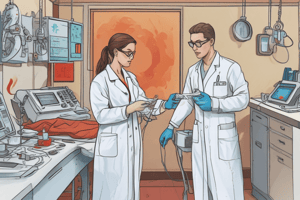Podcast
Questions and Answers
Why are collection tubes often color-coded?
Why are collection tubes often color-coded?
- To specify the patient's blood type.
- To denote the additives present in the tube. (correct)
- To signify the laboratory performing the test.
- To indicate the expiration date of the tube.
What is the typical pH range of blood?
What is the typical pH range of blood?
- 6.85-7.25
- 7.35-7.45 (correct)
- 7.00-7.30
- 7.50-7.60
In venipuncture, which vein is most commonly used?
In venipuncture, which vein is most commonly used?
- Basilic vein
- Femoral vein
- Medial cubital vein (correct)
- Cephalic vein
What is the approximate total blood volume in adult males?
What is the approximate total blood volume in adult males?
What effect does the presence of EDTA have on a blood sample?
What effect does the presence of EDTA have on a blood sample?
How does blood color relate to its oxygen content?
How does blood color relate to its oxygen content?
What percentage of body mass does blood approximately account for?
What percentage of body mass does blood approximately account for?
Which characteristic distinguishes blood from water?
Which characteristic distinguishes blood from water?
For what purpose would a procoagulant tube be used?
For what purpose would a procoagulant tube be used?
Which additive prevents coagulation?
Which additive prevents coagulation?
Which of the following describes the relative viscosity of blood?
Which of the following describes the relative viscosity of blood?
How much of the extracellular fluid does blood account for?
How much of the extracellular fluid does blood account for?
If blood is bright red during blood collection, what does this indicate about the blood's characteristics?
If blood is bright red during blood collection, what does this indicate about the blood's characteristics?
Why is it important to select the correct blood collection tube for specific laboratory tests?
Why is it important to select the correct blood collection tube for specific laboratory tests?
What is the primary function of citrate as an additive in blood collection tubes?
What is the primary function of citrate as an additive in blood collection tubes?
Which of the following is a key characteristic of blood that affects its flow properties?
Which of the following is a key characteristic of blood that affects its flow properties?
How does the use of collection tubes with anticoagulants impact downstream laboratory testing?
How does the use of collection tubes with anticoagulants impact downstream laboratory testing?
When might a phlebotomist choose a vein other than the medial cubital vein for venipuncture?
When might a phlebotomist choose a vein other than the medial cubital vein for venipuncture?
What consideration is most important when choosing the correct order of draw for multiple blood collection tubes?
What consideration is most important when choosing the correct order of draw for multiple blood collection tubes?
What percentage of total body weight does extracellular fluid (ECF) typically constitute in a 70kg person?
What percentage of total body weight does extracellular fluid (ECF) typically constitute in a 70kg person?
Which of the following characteristics describes the composition of intracellular fluid (ICF)?
Which of the following characteristics describes the composition of intracellular fluid (ICF)?
Which of the following is a key difference between plasma and interstitial fluid?
Which of the following is a key difference between plasma and interstitial fluid?
What is the approximate volume of blood in a 70kg person, based on the rule of thumb provided?
What is the approximate volume of blood in a 70kg person, based on the rule of thumb provided?
What is the primary purpose of using an anticoagulant, such as heparin or EDTA, when collecting blood into a tube?
What is the primary purpose of using an anticoagulant, such as heparin or EDTA, when collecting blood into a tube?
After centrifuging a tube of blood, what percentage of the total blood volume does the plasma typically represent?
After centrifuging a tube of blood, what percentage of the total blood volume does the plasma typically represent?
How does the water content in the body typically differ between males and females?
How does the water content in the body typically differ between males and females?
Which of the following is a characteristic of blood plasma?
Which of the following is a characteristic of blood plasma?
What is the approximate volume of transcellular fluid in a 70kg person?
What is the approximate volume of transcellular fluid in a 70kg person?
Given that a typical 70kg male contains approximately 42L of water, what percentage of his total body weight does this water represent?
Given that a typical 70kg male contains approximately 42L of water, what percentage of his total body weight does this water represent?
What are the main components that blood centrifugation separates?
What are the main components that blood centrifugation separates?
Which formed element makes up the highest percentage of whole blood?
Which formed element makes up the highest percentage of whole blood?
What is the main difference in function between blood and lymph?
What is the main difference in function between blood and lymph?
Which of the following parameters is lower in the fluid outside of cells?
Which of the following parameters is lower in the fluid outside of cells?
Which of the following parameters describes intracellular fluid?
Which of the following parameters describes intracellular fluid?
What does the presence of buffy coat comprised leukocytes and platelets typically present following centrifugation of blood?
What does the presence of buffy coat comprised leukocytes and platelets typically present following centrifugation of blood?
Which of the following blood components contains albumin, globulins, fibrinogen, electrolytes, gases, regulatory substances, nutrients and waste products?
Which of the following blood components contains albumin, globulins, fibrinogen, electrolytes, gases, regulatory substances, nutrients and waste products?
Under normal circumstances, which of the following solutes would be found in slightly higher concentrations in plasma than in interstitial fluid?
Under normal circumstances, which of the following solutes would be found in slightly higher concentrations in plasma than in interstitial fluid?
What percentage of water is contained in blood plasma?
What percentage of water is contained in blood plasma?
Which of the following fluid types helps bathes all cells, including lymph?
Which of the following fluid types helps bathes all cells, including lymph?
Which plasma protein is primarily responsible for maintaining osmotic pressure and transporting insoluble molecules?
Which plasma protein is primarily responsible for maintaining osmotic pressure and transporting insoluble molecules?
Globulins, a class of plasma proteins, are known for which primary function?
Globulins, a class of plasma proteins, are known for which primary function?
What role does fibrinogen play in blood?
What role does fibrinogen play in blood?
Plasma solutes are composed of electrolytes, nutrients, and respiratory gases, and they account for approximately what percentage of total plasma?
Plasma solutes are composed of electrolytes, nutrients, and respiratory gases, and they account for approximately what percentage of total plasma?
If a patient's blood gas analysis reveals an oxygen saturation of 75%, what does it indicate?
If a patient's blood gas analysis reveals an oxygen saturation of 75%, what does it indicate?
What is the typical range of sodium (Na+) concentration in blood plasma?
What is the typical range of sodium (Na+) concentration in blood plasma?
What is the normal range for blood pH?
What is the normal range for blood pH?
What is the average range of plasma protein levels considered normal?
What is the average range of plasma protein levels considered normal?
What is the normal range of potassium (K+) concentration in blood plasma?
What is the normal range of potassium (K+) concentration in blood plasma?
What is the normal concentration range of calcium (Ca2+) in blood plasma?
What is the normal concentration range of calcium (Ca2+) in blood plasma?
What is the normal range of magnesium (Mg2+) concentration in blood plasma?
What is the normal range of magnesium (Mg2+) concentration in blood plasma?
What is the typical range of chloride (Cl-) concentration in blood plasma?
What is the typical range of chloride (Cl-) concentration in blood plasma?
What is the normal range of bicarbonate (HCO3-) concentration in blood plasma?
What is the normal range of bicarbonate (HCO3-) concentration in blood plasma?
What is the range of cholesterol concentration typically found in blood plasma?
What is the range of cholesterol concentration typically found in blood plasma?
What is the typical concentration range of urea in blood plasma?
What is the typical concentration range of urea in blood plasma?
Given the role of plasma proteins, what might be the consequence of significantly low levels of albumin in the blood?
Given the role of plasma proteins, what might be the consequence of significantly low levels of albumin in the blood?
Elevated blood urea levels could suggest impairment where?
Elevated blood urea levels could suggest impairment where?
How does the amount of oxygen saturation affect blood characteristics?
How does the amount of oxygen saturation affect blood characteristics?
Individuals with compromised liver function may exhibit reduced levels of which plasma protein?
Individuals with compromised liver function may exhibit reduced levels of which plasma protein?
If a blood test reveals a patient's plasma protein levels are consistently above 80 g/L, what could this indicate?
If a blood test reveals a patient's plasma protein levels are consistently above 80 g/L, what could this indicate?
Flashcards
Blood viscosity
Blood viscosity
Blood is more viscous than water.
Venipuncture site
Venipuncture site
The medial cubital vein is the most common site for venipuncture.
Vacutainer colors
Vacutainer colors
Each vacutainer is color-coded to indicate its contents.
Blood pH range
Blood pH range
Signup and view all the flashcards
Anticoagulant additives
Anticoagulant additives
Signup and view all the flashcards
Blood color and oxygen
Blood color and oxygen
Signup and view all the flashcards
Heparin
Heparin
Signup and view all the flashcards
Citrate
Citrate
Signup and view all the flashcards
EDTA
EDTA
Signup and view all the flashcards
Procoagulant tubes
Procoagulant tubes
Signup and view all the flashcards
Blood volume composition
Blood volume composition
Signup and view all the flashcards
Total blood volume
Total blood volume
Signup and view all the flashcards
Intracellular Fluid (ICF)
Intracellular Fluid (ICF)
Signup and view all the flashcards
Extracellular Fluid (ECF)
Extracellular Fluid (ECF)
Signup and view all the flashcards
Transcellular Fluid
Transcellular Fluid
Signup and view all the flashcards
Interstitial Fluid
Interstitial Fluid
Signup and view all the flashcards
Plasma
Plasma
Signup and view all the flashcards
Male Body Water Percentage
Male Body Water Percentage
Signup and view all the flashcards
Female Body Water Percentage
Female Body Water Percentage
Signup and view all the flashcards
Blood Centrifugation
Blood Centrifugation
Signup and view all the flashcards
Appearance of Plasma
Appearance of Plasma
Signup and view all the flashcards
Fluid Analysis
Fluid Analysis
Signup and view all the flashcards
High Intracellular Ions
High Intracellular Ions
Signup and view all the flashcards
Low Intracellular Ions
Low Intracellular Ions
Signup and view all the flashcards
Anticoagulant Use
Anticoagulant Use
Signup and view all the flashcards
Plasma Percentage
Plasma Percentage
Signup and view all the flashcards
Plasma Proteins
Plasma Proteins
Signup and view all the flashcards
Albumin
Albumin
Signup and view all the flashcards
Globulins
Globulins
Signup and view all the flashcards
Fibrinogen
Fibrinogen
Signup and view all the flashcards
Plasma Protein Range
Plasma Protein Range
Signup and view all the flashcards
Plasma Solutes
Plasma Solutes
Signup and view all the flashcards
Oxygenated Blood Saturation
Oxygenated Blood Saturation
Signup and view all the flashcards
Deoxygenated Blood Saturation
Deoxygenated Blood Saturation
Signup and view all the flashcards
Normal Blood pH
Normal Blood pH
Signup and view all the flashcards
Study Notes
- Plasma proteins normally range from 60-80g/L, making up 7% of total plasma
Plasma Proteins
- Albumin maintains osmotic pressure in blood and transports insoluble molecules
- Globulins (alpha, beta, and gamma) transport ions, hormones, and lipids and assist in immune function
- Fibrinogen is a molecular component involved in blood coagulation
Plasma Solutes
- Plasma is 1.5% total plasma, and contains over 100 solutes including electrolytes, nutrients, and respiratory gases
Cations
- Sodium (Na+) concentration is 135-145 mM
- Potassium (K+) concentration is 3.5-5.5 mM
- Calcium (Ca2+) concentration is 2-2.5 mM
- Magnesium (Mg2+) concentration is 1-1.5 mM
Anions
- Chloride (Cl-) concentration is 95-107 mM
- Bicarbonate (HCO3-) concentration is 22-26 mM
- Hydrogen Phosphate (HPO42-) and Dihydrogen Phosphate (H2PO4-) concentration is 1.5-2 mM
- Lactate and Sulfate (SO42-) concentration is ~5 mM
Other Plasma Components
- pH ranges from 7.35-7.45
- Glucose concentration is 4.5-5.5 mM
- Amino acid concentration is ~2 mM
- Cholesterol concentration is 3.5-5.5 mM
- Urea concentration is 2.5-6.5 mM
- Oxygen saturation is 98-99% when oxygenated and 75% when deoxygenated
Studying That Suits You
Use AI to generate personalized quizzes and flashcards to suit your learning preferences.




